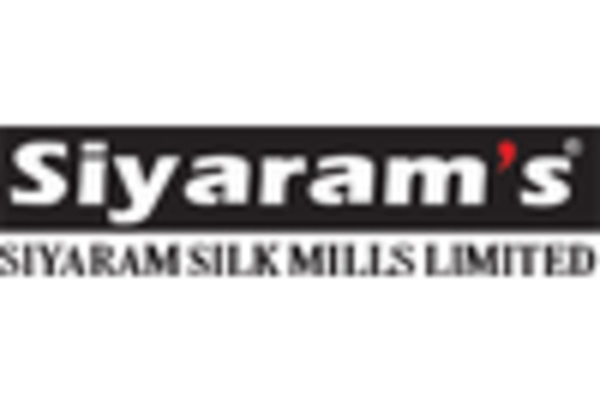The silk market exhibits a dynamic competitive landscape characterized by a blend of traditional craftsmanship and modern innovation. Key growth drivers include increasing consumer demand for luxury textiles, heightened awareness of sustainable practices, and the integration of technology in production processes. Major players such as Sichuan Nanchong Silk Group (CN), Sanjin Silk Co. Ltd. (CN), and Jiangsu Soho International Group (CN) are strategically positioned to leverage these trends. Sichuan Nanchong Silk Group (CN) focuses on expanding its product range to include eco-friendly silk options, while Sanjin Silk Co. Ltd. (CN) emphasizes digital transformation to enhance customer engagement and streamline operations. Jiangsu Soho International Group (CN) is actively pursuing partnerships with fashion brands to co-develop innovative silk products, thereby shaping a competitive environment that prioritizes sustainability and technological advancement.
In terms of business tactics, companies are increasingly localizing manufacturing to reduce lead times and enhance supply chain resilience. The market structure appears moderately fragmented, with a mix of established players and emerging brands vying for market share. The collective influence of these key players fosters a competitive atmosphere where innovation and quality are paramount, as companies seek to differentiate themselves in a crowded marketplace.
In October 2025, Sichuan Nanchong Silk Group (CN) announced a collaboration with a leading fashion house to create a limited-edition silk collection that emphasizes sustainable sourcing. This strategic move not only enhances the company's brand image but also aligns with the growing consumer preference for environmentally responsible products. By tapping into the luxury segment, the company positions itself to capture a more affluent customer base, potentially increasing its market share.
In September 2025, Sanjin Silk Co. Ltd. (CN) launched an advanced e-commerce platform aimed at improving customer experience and expanding its reach in the digital marketplace. This initiative reflects a broader trend towards digitalization within the industry, as companies recognize the importance of online sales channels in reaching a global audience. The platform's user-friendly interface and personalized shopping experience are likely to enhance customer loyalty and drive sales growth.
In August 2025, Jiangsu Soho International Group (CN) entered into a strategic alliance with a technology firm to integrate AI-driven analytics into its production processes. This partnership aims to optimize supply chain management and improve operational efficiency. By leveraging AI, the company can better predict market trends and consumer preferences, thereby enhancing its competitive edge in a rapidly evolving market.
As of November 2025, current competitive trends are increasingly defined by digitalization, sustainability, and the integration of advanced technologies such as AI. Strategic alliances are playing a crucial role in shaping the landscape, enabling companies to pool resources and expertise to drive innovation. Looking ahead, competitive differentiation is likely to evolve from traditional price-based competition to a focus on innovation, technology, and supply chain reliability. Companies that successfully navigate these trends will be better positioned to thrive in the silk market.

















Leave a Comment